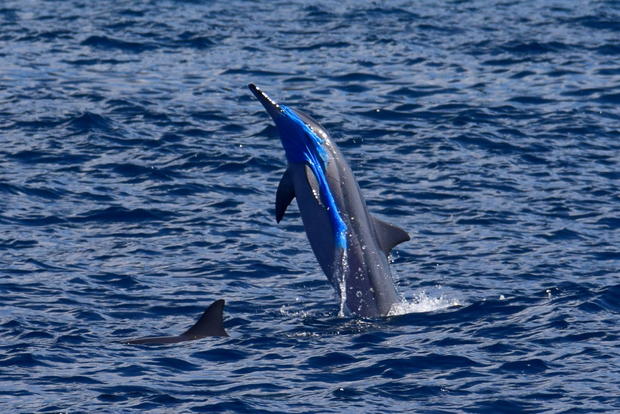How Much Animals Are Dying From Plastic
A decade of plastic has entangled, choked and drowned over 1,500 endangered marine mammals in U.S. waters, new report finds
In Florida, a sea turtle drowned after a plastic handbag filled with sand wrapped around its neck. In Virginia, a sei whale developed gastric ulcers, harming her ability to find food, after a DVD example she swallowed lacerated her breadbasket. In Delaware, a immature, emaciated airplane pilot whale was establish dead with instant-ramen noodle bags in its gut.
Endangered marine animals, threatened with extinction, are losing their boxing confronting plastic in the United States. Well-nigh 1,800 of them, including a significant number of bounding main turtles, take consumed or become entangled in plastic since 2009 — and a new written report says the true numbers are likely much more than devastating.
Oceana, the world'southward largest ocean conservation organization, released a report Thursday, detailing, for the get-go time, information showing plastic's bear upon on marine mammals and ocean turtles in the U.S. Of the ane,792 examples studied, a stunning 88% featured animals listed as endangered or threatened with extinction under the Endangered Species Human activity, including Hawaiian monk seals, manatees, Steller sea lions and all 6 species of U.S. sea turtle.
The new report sheds lite on yet some other life-threatening take chances for these loftier-risk creatures. Marine mammals already battle pollution, habitat loss and destruction, commercial fishing gear, vessel strikes, illegal poaching and harmful algal blooms — not to mention a plethora of climate crises, from sea level rise to warming oceans.
Researchers surveyed dozens of authorities agencies, organizations and institutions to collect the data, which spans twoscore different species. Oceana says the number of animals surveyed is far fewer than the actual number afflicted by the overflowing of plastics into our oceans, which it called "an unfolding disaster."
"While there may never be a consummate business relationship of the fate of all marine animals impacted past plastic, this study paints a grim picture," study writer Dr. Kimberly Warner, a senior scientist at Oceana, said in a news release. "The world is hooked on plastic because the industry continues to find increasingly more ways to force this persistent pollutant into our everyday routines — and it'southward choking, strangling and drowning marine life."
Warner said the plastics found in the study are non just the everyday items such equally water bottles, bags and bottle caps. Rather, the animals consumed or were entangled past everything from zip ties to dental flossers to recreational fishing line to food wrappers. Additional items included straws, toothbrushes, bubble wrap, children's toys, balloons and sandwich bags.
Researchers only expect the situation to get worse as Americans go on to overuse single-utilise plastics, contributing to the estimated 300 million tons of plastic waste the United nations said is produced every yr.
Co-ordinate to the report, plastics affect marine animals at all stages of life, including recently hatched bounding main turtles and seal mothers in the process of nursing their pups. And the plastics ranged widely in size, from microplastics to huge plastic sheets.
Plastic consumption was the overwhelming theme of the report, detailed in 90% of the total animal cases reviewed. Researchers said entanglement, ofttimes involving numberless, balloons and plastic sheeting, was still meaning, affecting animals in "heartbreaking, sometimes gruesome, ways."
When animals eat plastic, either because they mistook information technology for food or swallowed information technology inadvertently while feeding or pond, it can both obstruct digestion and lacerate intestines, leading to starvation and expiry. Entanglement tin can also lead to malnutrition, as well equally drowning, choking, amputation or infection, the written report said.
Animals practise not need to consume a significant amount of plastic for it to have lethal effects. In some cases, ingesting just 1 piece of plastic proved deadly.
Researchers found animals in U.S. waters eat plastic at higher amounts than is expected worldwide. Some sea turtle groups studied consumed plastic up to three times more often than boilerplate for their species, while the northern fur seal consumed plastic up to 50 times more frequently than average for eared seals.
The findings echo a paper released last month that found the U.S. has generated the most plastic waste globally, a large portion of which was establish in the environment.
"This report is merely a snapshot of what's happening to the animals inhabiting plastic-polluted waters around the Usa — imagine how great the numbers would be if they included the animals not observed or documented by humans," said co-author Christy Leavitt, plastics campaign director at Oceana.
According to Oceana, plastic product is expected to quadruple in the next few decades, leading to three times the amount of plastic in the body of water by 2040. The arrangement called on national, country and local governments to pass policies ensuring companies finish producing unnecessary plastic, especially equally the necessary production of plastics for medical use has skyrocketed during the coronavirus pandemic.
Oceana recommended companies instead offer plastic-gratis choices for consumers, including reusable and refillable containers and packaging. It also called on federal agencies, including NOAA Fisheries and the U.S. Fish and Wildlife Service, to meliorate their reporting standards of animals interacting with plastics.
"Plastic is designed to concluding forever, nonetheless so much of it is used just once," the report states. "This makes it an obvious target for policies aimed at reducing harmful ocean pollution."
Thanks for reading CBS NEWS.
Create your free business relationship or log in
for more features.
Source: https://www.cbsnews.com/news/plastic-pollution-entangle-choke-endangered-marine-mammals-oceana-report/
Posted by: whiteeatilten.blogspot.com






0 Response to "How Much Animals Are Dying From Plastic"
Post a Comment